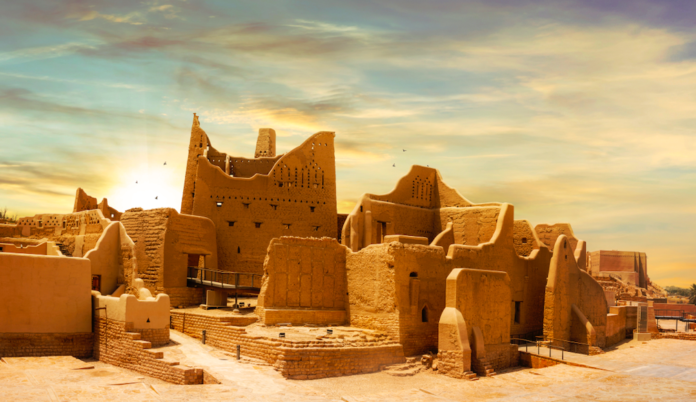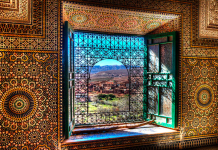Saudi Arabia is benefiting from its rich history to boost cultural tourism as international travellers are increasingly seeking authentic and varied experiences.
With the World Heritage site At-Turaif, home of the First House of the Al Saud family and capital of the first Saudi State, at its centre, giga-project Diriyah Gate is set to attract 27 million visits annually, 7 million of which are from abroad, explained Talal Kensara, chief strategic management officer at the Diriyah Gate Development Authority (DGDA).
Diriyah Gate will be spread over 14 million square metres, 3.5 million of which will be dedicated to pedestrians. As such, the first phase of implementation has begun with the infrastructure work, which Kensara refers to as “complicated” since a lot of digging is needed to accommodate underground transport structures.
While the overall completion date is set for 2030, Kensara explains that elements of the project will be revealed annually, leading up to that date “so people will have the opportunity to live and feel the project starting quarter three of this year.” This year will see the launch of Bujairi District, which features 19 fine dining outlets, including Hakkasan, Long Chim and two new Saudi fine dining concepts.
In a wide reaching interview with Arabian Business, at the side-lines of the Arabian Travel Market tradeshow, Kensara discussed how Diriyah Gate contributes to developing tourism in Saudi Arabia and harmonises with the kingdom’s Vision 2030. Mixed use urban development based mainly in a cultural heritage experience that has been inspired by the significant history of Diriyah, the birthplace of the kingdom and the capital for the first Saudi state.
AB: How does Diriyah contribute to tourism in Saudi Arabia?
It will have a very significant impact because we are expecting to have 27 million visits annually by 2030, with 7 million of those coming from abroad. So we are tapping into the whole demand of Riyadh now which in itself is growing rapidly and offering varied experiences.
What we are seeing nowadays, especially post-Covid, is that people want to experience something different on their travels. So Diriyah is an opportunity to tell the story of our cultures and traditions, allowing people to really experience our country.
Because of the historical aspect, which is reflected in every element of the project, we believe we are offering something different; it’s not like you are going into a typical metropolitan area.
AB: How many people will be working in Diriyah?
We are aiming to have created 55,000 jobs by 2030 and we believe that we can achieve this target because of two elements.
One is hospitality. We will have 38 hotels across the project and we want a lot of Saudis to work in them. This is why we have a scholarship and training programme where Saudis are trained in the different fields of hospitality.
The second element is culture. Travellers and nationals are really excited by culture and it [cultural tourism] is something we have not really practiced in a professional way for the last forty years. This is evidenced by the high number of Saudi youngsters who are excited to work in the cultural sector be it in the visual, the culinary, museums or the performance arts among others.
We have already started training a lot of the tour guides for the museum curation and work in the galleries and content creation.

AB: How does all what we talked about tie in with Saudi’s Vision 2030?
One of the elements in Vision 2030 is celebrating Saudi identity which is what we are doing by celebrating the birthplace of the kingdom and allowing all people to create an emotional connection with Diriyah.
We Saudis have studied about At-Turaif’s legacy in our history books but we didn’t get to build that emotional connection which comes from experiencing these stories.
Hospitality is another main pillar of Vision 2030 which is reinforced with Diriyah but the cultural element remains a huge value proposition with our site.
AB: How do you see the future of tourism and how do Saudi Arabia specifically, and the GCC, tie into that?
People want to travel to a place where they can have multi-experiences in the same setting instead of travelling to different destinations and exposing themselves to the hassle of precautions and security.
They want to get entertainment, fine dining and culture, all in one place. So I think Saudi Arabia will be a great destination because we have that mix: the variety of nature and culture that we have in the kingdom will help us to do that.
We complement the GCC so far. Dubai currently attracts visitors from areas such as Australia, North and South America and that will help us by collaborating with the emirate and developing joint packages.
We are learning a lot from Dubai’s experience especially when it comes to destination management and I think we can collaborate a lot.
The World Cup is coming up in Qatar and we are designing packages where people can watch the matches and then spend a few days in Riyadh or historical Jeddah or AlUla so we feel that it is happening today in the GCC.
We are all committed to each other and we are helping by offering this nature element with our mountains, the Red Sea coast and historical elements.
For all the latest business news from the UAE and Gulf countries, follow us on Twitter and Linkedin, like us on Facebook and subscribe to our YouTube page, which is updated daily.













